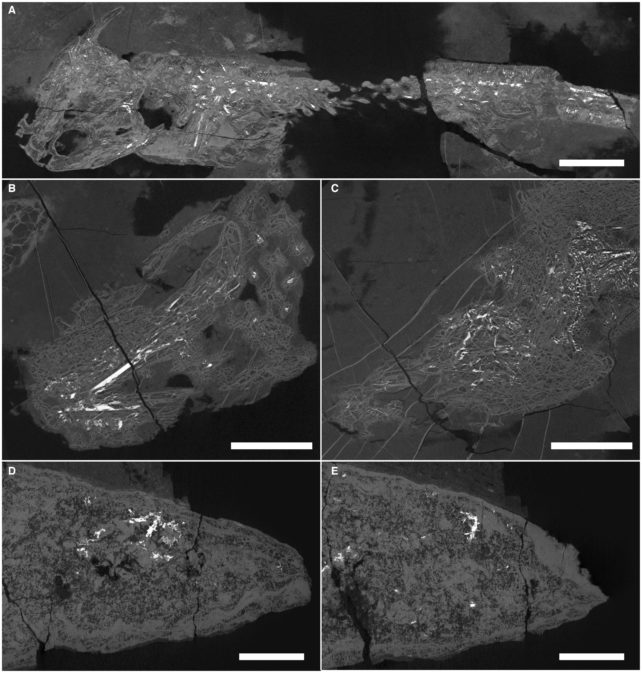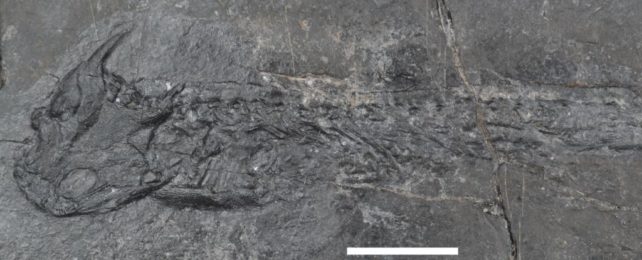The preservation of ancient bones is a marvelous phenomenon. So exceptionally can these remains be preserved that their internal structure remains intact, especially in a type of sedimentary fossil bed called a Lagerstätte.
But one particular Lagerstätte has left scientists puzzled for decades.
The Jarrow Assemblage in Ireland features a coal seam full of bones with internal structures so changed that it's difficult – and in some cases impossible – to make out details of the fish and amphibian-like tetrapods that left them.
Previously, scientists had attributed the altered structure of the bones to acidic waters in the swamp or lake in which the bones were first deposited conditions which meant the specimens "achieved fossilization – but only just".
This, however, is inconsistent with bones recovered from other coal swamp Lagerstätten that had similar palaeoenvironmental settings.
Now scientists from Ireland and the UK have examined the Jarrow bones in exhaustive detail and determined the cause of the altered bones: they were literally cooked by superheated fluids that seeped into the rock as a result of tectonic activity.
"This study demonstrates that the alteration observed at Jarrow is, in fact, largely due to hydrothermal fluids during deep burial," write a team led by paleontologist Aodhán Ó Gogáin of Trinity College Dublin in Ireland, "and is not a direct product of environmental conditions during the initial stages of burial or early diagenesis."
To get to the bottom of the bones' unique preservation, the researchers employed a number of techniques to reveal the chemistry therein. They combined high-resolution imaging with techniques to analyze the elemental composition and structure of materials, and discovered that what's in the bones isn't what we usually see in bones.

Rather, the bone has been partially replaced by coal and sphalerite (a mineral that can form in hydrothermal conditions), and the apatite crystals found therein were a different form from apatite crystals usually found in bones.
"The chemistry of the apatite crystals can tell us a lot about how it formed, whether it grew organically in the animal, formed when the animal was being buried or whether some other factors influenced its growth," says geologist Gary O'Sullivan of Trinity College Dublin.
"Apatite is a major constituent of living bone so it is no surprise we find some preserved in these bones. However, when we look at the chemistry of apatite in the bones from Jarrow we find that this apatite was formed by heated fluids within the Earth."
The chemistry of the bones suggests that hydrothermal fluids – superheated water from under Earth's crust – seeped into the rock, heating it to temperatures around 300 to 350 degrees Celsius (572 to 662 degrees Fahrenheit) and melting the apatite present in the bones. As the bones cooled, the apatite recrystallized into the tabular form the scientists observed.
Radiometric dating based on the decay of uranium isotopes dated these crystals to approximately 302 million years ago, clinching the theory.
"We have also been able to radiometrically date the apatite which shows it formed during a time when all the continents on Earth were coming together and colliding to form the supercontinent Pangaea," Ó Gogáin explains.
"As these continents collided, they formed mountain belts with super-heated subterranean fluids flowing of them. It is these superheated fluids, which flowed throughout Ireland that cooked and melted the bones of these fossils causing the alteration we see today."
The team proposes that, following the deaths of the fish and tetrapods, their bones were transported a short distance and buried rapidly, preserving almost completely articulated skeletons and scaly skins. As they were buried, the bones became compressed, resulting in fracturing. This fracturing allowed hydrothermal fluids to infiltrate the bones, altering their chemistry and structure.
As far as we know, this is unique to Jarrow, and helps contextualize the history of the formation and its bones.
"The Jarrow assemblage is of major scientific importance and is a significant element of Ireland's geoheritage," says paleontologist Patrick Wyse Jackson of Trinity College Dublin. "It is great that finally the question of what altered the fossil bones of these animals has been resolved."
The research has been published in Palaeontology.
